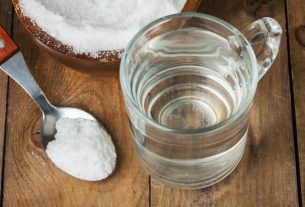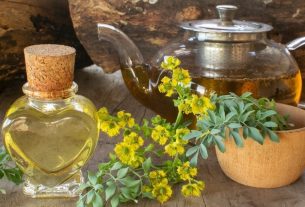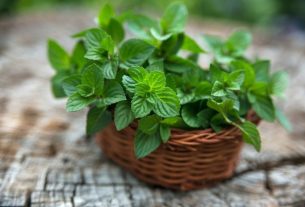Ginseng is a medicinal plant that helps promote physical and mental disposition, improve mood and reduce fatigue, as it contains stimulating and revitalizing properties.
Furthermore, ginseng also has adaptogenic action, helping to reduce stress and anxiety, because it reduces the production of cortisol, a hormone that is released in greater quantities during periods of stress.
The main types of ginseng are Korean, Brazilian and American, which have similar properties and are found in health food stores or pharmacies, in white or red, and in the form of root, tincture, powder, capsules or in infusion sachets.
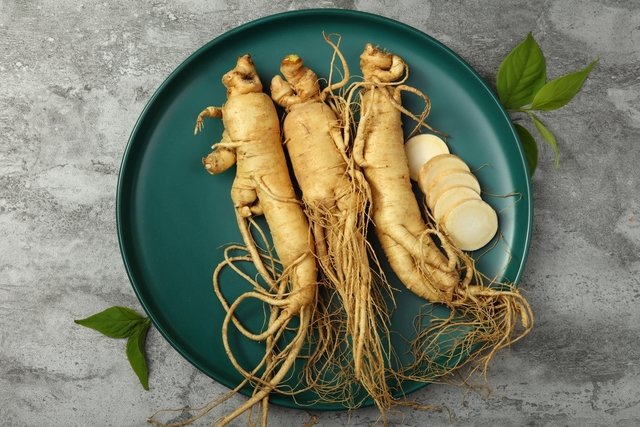
What is it for
Because it has adaptogenic and antioxidant action, ginseng is used in the following situations:
1. Promote physical disposition
Ginseng promotes physical disposition because it reduces fatigue and increases agility and resistance, and can be recommended to improve the performance of athletes and those involved in physical activities.
2. Decrease stress and anxiety
Ginseng contains saponins, bioactive compounds that stimulate the production of dopamine, a neurotransmitter that promotes general well-being, reducing stress and anxiety.
3. Improve sexual performance
By improving blood circulation and acting on the nervous system by stimulating the production of dopamine, ginseng increases the sensation of pleasure and libido, improving sexual performance.
4. Improve memory and concentration
Ginseng acts directly on the hippocampus, the area of the brain responsible for memory, improving attention and concentration, making it a good option for students during assessment periods, for example.
5. Strengthen the immune system
Because it has an immunomodulatory effect, ginseng increases the number of immune cells in the blood and strengthens the immune system, preventing the onset or shortening the duration of colds and flu.
6. Improve blood circulation
Ginseng contains ginsenosides, which are bioactive compounds responsible for releasing nitric oxide, a substance that relaxes blood vessels, improving blood circulation.
7. Avoid cardiovascular diseases
Because it has antioxidant action, ginseng fights free radicals, preventing the oxidation of fat cells, balancing “bad” cholesterol levels, LDL, in the blood and preventing cardiovascular diseases, such as atherosclerosis and heart attack.
8. Prevent the emergence of cancer
Because it is rich in antioxidant compounds such as saponins and flavonoids, ginseng helps fight free radicals and can prevent the emergence of some types of cancer, such as lung, liver, pancreas, ovary and stomach.
However, more research is needed to prove this possible benefit of ginseng in preventing cancer.
Types of ginseng
There are different types of ginseng, which have similar properties, but which vary according to their composition and place of origin:
- Korean ginseng (Panax ginseng CA Meyer): Originating from China and Korea and considered the “true ginseng”, this plant is rich in ginsenosides, substances that strengthen the immune system, reduce tiredness, improve mood and disposition;
- Brazilian ginseng (Pfaffia glomerata): considered the “true substitute” for Korean ginseng, this plant contains fameric acid, glomeric acid and ecdysterone, compounds that improve memory, strengthen the immune system and reduce anxiety and stress;
- American Ginseng (Panax quinquefolius): grown in the United States and Canada, this type of ginseng is also rich in ginsenosides, having the same properties as Korean ginseng;
- Ginseng indiano (Withania somnifera): also known as ashwagandha, it is a root rich in alkaloids, lactones and saponins, compounds with calming and stimulating properties, and is widely used to improve physical and mental performance, in addition to reducing anxiety. Learn more about Indian ginseng.
- Ginseng siberiano (Eleutherococcus senticosus): of Chinese and Russian origin, this plant, also known as eleuthero, contains eleutherosides, compounds with immunomodulatory action that strengthen the immune system and help treat depression, mental fatigue and lack of concentration;
The type of ginseng recommended varies according to the objective being treated. Therefore, to choose the best type of ginseng, it is recommended to consult a doctor or other health professional specialized in the use of medicinal plants.
How to use
Fresh or dried ginseng root can be used in powder form, in the form of teas, tinctures or capsules:
- Ginseng powder: dissolve 1 teaspoon per day, diluted in juices or meals;
- Tea: consume 2 to 3 cups of tea per day, with meals;
- Dyeing: Dilute 1 tablespoon in a glass of water and take daily with meals.
Furthermore, ginseng can also be used in the form of capsules and the recommended daily dose varies between 40mg and 500mg, which can be taken between 1 and 4 capsules or tablets per day, and should be taken with meals.
As the type, dosage and duration of use of ginseng varies according to the health condition and objective being treated, it is recommended to consult a doctor or other health professional specialized in the use of medicinal plants before using this plant.
Recipes with ginseng
Some ginseng recipes include teas, soups and tinctures:
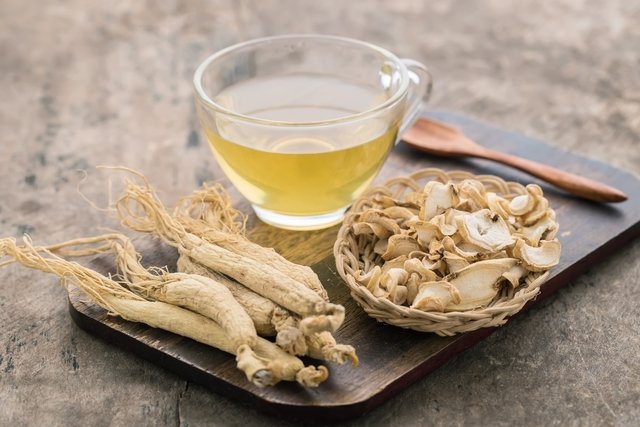
1. Ginseng tea
Ingredients:
- 150 ml of water;
- 0.5g to 2g shaved ginseng root.
Preparation mode:
Bring the water to a boil and, when it is bubbling, add the ginseng. Cover the pan and leave on low heat for 10 to 20 minutes. Strain and drink 2 to 3 cups a day.
2. Ginseng noodle soup
Ingredients:
- 1.5 liters of water;
- 15g fresh ginseng root;
- 3 onions;
- 3 cloves of garlic;
- 1 carrot;
- 2.5 cm of ginger;
- 150 g of mushrooms;
- 200 g of pasta;
- 1 handful of chopped parsley;
- Salt and pepper to taste;
- 2 tablespoons of olive oil for sautéing.
Preparation mode:
In a pan, sauté the garlic and onion in olive oil until golden. Add the water, ginseng, carrot, ginger and mushrooms, cooking over medium heat until the carrot is soft. Add the pasta and season to taste. Let it cook until the dough is soft. Remove the ginseng and ginger, discarding them, and serve the soup while it is still hot.
3. Tincture of ginseng
Ingredients:
- 25 g de goji;
- 25 g de ginseng;
- 25 g of oats;
- 5 g of licorice root;
- 400 ml of vodka.
Preparation mode:
Chop all the ingredients and place in a clean, sterilized dark glass container. Cover the ingredients well with vodka, cover and leave the mixture in a cupboard for 3 weeks.
After this time, simply strain and store the tincture in a cupboard, in a dark glass container, using it for up to 6 months. To take, simply dilute 1 tablespoon of this tincture in a glass of water daily and always with meals.
Possible side effects
The side effects that are generally related to the consumption of ginseng are nausea, vomiting, diarrhea and abdominal pain.
Ginseng can also cause nervousness or insomnia, especially if used in high doses or combined with foods that are sources of caffeine, such as coffee, green tea and cocoa, for example.
Although they are rarer, the use of ginseng can also cause high blood pressure, anxiety, headache, nosebleeds or hypoglycemia.
Ginseng should not be used for more than 3 months, and it is recommended to take periodic breaks while using this plant.
Who cannot use
Ginseng is not recommended for children, people with heart disease or bipolar disorder. It is also not recommended for pregnant or breastfeeding women.
People who use medicines to control blood pressure or diabetes, anticoagulants, immune system modulators, stimulants, hormone replacements, contraceptives, morphine or antidepressants should talk to their doctor before using ginseng, as this plant can alter the effects of these medicines. .

Sign up for our newsletter and stay up to date with exclusive news
that can transform your routine!
Warning: Undefined array key "title" in /home/storelat/public_html/wp-content/plugins/link-whisper-premium/templates/frontend/related-posts.php on line 12
Warning: Undefined array key "title_tag" in /home/storelat/public_html/wp-content/plugins/link-whisper-premium/templates/frontend/related-posts.php on line 13

